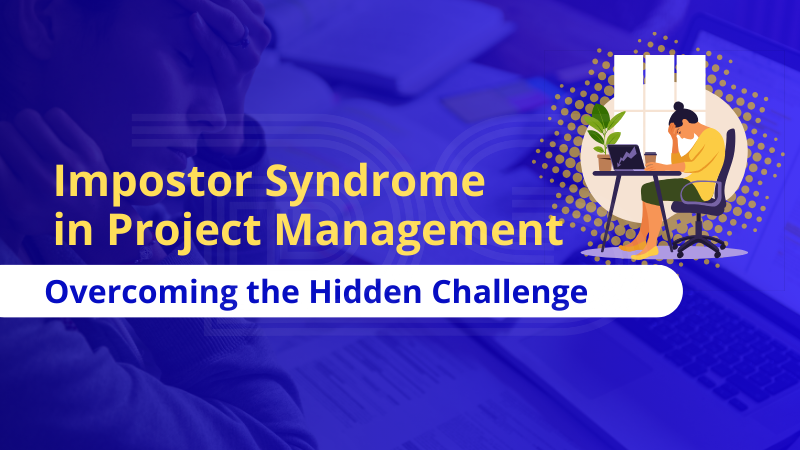
by Dharam CW2 | Jan 10, 2025 | Professional Resilience and Inspiration Stories
Impostor syndrome is a psychological disorder where individuals mistrust their abilities, leading to decreased productivity, increased stress, anxiety, and work satisfaction. IT project managers often experience this issue, distrusting their team’s communication, leadership, and decision-making abilities.
This article explores the causes of impostor syndrome in project management, its psychological and professional impact, and actionable strategies to overcome it.
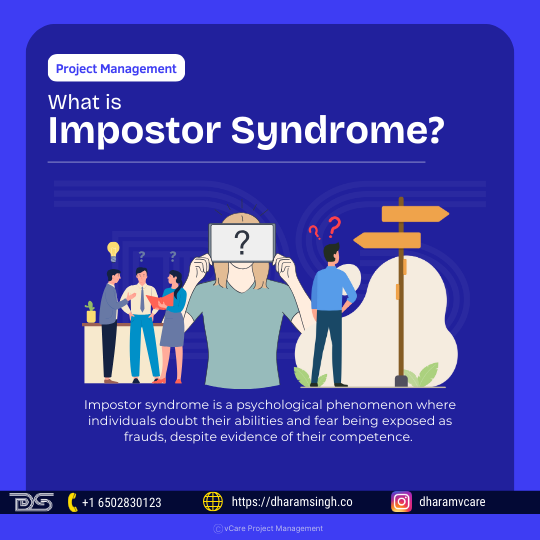
What is Impostor syndrome?
Project management awareness of Impostor syndrome
Project managers frequently feel like frauds, despite their accomplishments. The impostor syndrome causes people to distrust themselves. They’re worried about disappointing their teammates. It stems from the high expectations in project management. The term “impostor syndrome” was coined by Pauline Clance and Suzanne Imes, to describe chronic self-doubt, dread of failure, and the conviction that achievement is due to luck or fortunate timing. It is a major professional difficulty in project management, affecting performance, decision-making, and team relations.
A KPMG: Women’s Leadership study found that 75% of female executives experienced impostor syndrome, with project managers being particularly vulnerable.
Why It Matters in Project, Program, and Portfolio Management
Project, program, and portfolio managers are important to the performance of organizations, which makes impostor syndrome crucial. It is concerned with making certain that strategic projects are properly carried out and completed effectively, on schedule, and within budget. These professionals’ roles typically expose them to scrutiny from team members, senior leadership, and stakeholders; as a result, self-doubt can have disastrous consequences.
General reasons why the impostor syndrome is important in this discipline include:

General reasons why the impostor syndrome is important Project, Program, and Portfolio Management?
- Leadership Pressure: The managers of a project are considered decision-makers and problem solvers. Hesitation and loss of confidence can undermine leadership authority and destroy team trust.
- Stakeholder Management: Stakeholder management requires assertive communication about managing expectations from clients, sponsors, and cross-functional teams. Impostor syndrome creates second-guessing abilities to meet the expectations of stakeholders.
- Visibility and accountability: Project managers function under very visible conditions that exhibit success and failure intensely, and the more successful one of these projects is, the further it raises the reputation, or the worse, failing it may attract public attention in creating self-doubting notions.
- Effectiveness with Teams: The inadequacies of a project manager have a ripple effect on those teams, thus influencing their confidence and productivity.
Identifying Its Challenges in High-Stakes Situations
The high stakes of project management provide the perfect breeding ground for impostor syndrome. Here’s why:
- Project Managers’ Multifaceted Function
A project manager can serve a range of roles, including leader, planner, communicator, mediator, and risk management. Even professionals may feel inadequate at times due to the diversity of roles.
- Fast-paced and Changing Work Environments
The project management field evolves with new methodologies such as Agile, Lean, and Six Sigma, tools, and technologies. In this setting, one cannot keep up to date, and in the attempt to transition from traditional ways of handling project management, one is always left inadequate. Fast-paced changes in priorities with very short deadlines don’t help as well and just amplify self-doubt by squeezing little time for error.
- The Need for Perfectionism
Usually, project managers fall prey to the pressure of being perfect and over prepare or fear delegation. Perfection emerges because he believes that if he fails, everyone else will expose his ineptness.
- Cultural and Gender Dynamics
Cultural expectations, such as respect for authority or not wanting to boast, can heighten impostor syndrome. In some cultures, voicing doubts or seeking assistance is perceived as a sign of weakness. Women and minorities in project management positions experience impostor syndrome more keenly because of systemic biases and underrepresentation in leadership roles.
- Dynamic Stakeholder Relationships
It is particularly difficult to manage relationships with stakeholders that have divergent expectations or interests. The urge to constantly “prove themselves” is a common one among project managers, particularly in politically heated workplaces.
Signs of Impostor Syndrome in Project Managers
- Deny receiving compliments or explain success away using outside reasons.
- Desperation to prove one’s work: This involves seeking self-validation through peer or third parties’ validation.
- They avoid risky tasks or roles/positions.
- Work overtime or exert excessive efforts just to correct imagined deficiencies.
- Successes occurred by chance or good fortune.

Signs of Impostor Syndrome in Project Managers
Once such understanding is gained about the nature of impostor syndrome and the specific challenges it brings in project management, it would be easier for professionals to take the first step toward resolution. Identifying such feelings early and acknowledging the fact that many people experience them will help lay the foundation for self-doubt and building confidence in their roles.
The Psychological Toll: Emotional and Professional Impacts
Impostor syndrome can significantly affect the psychological well-being and performance at work of project managers. The fear of being exposed as incompetent despite evidence to the contrary leads to the perpetuation of self-doubting, overcompensating, and eventually burnout. It is, therefore, essential to understand in detail the impacts that may lead to addressing the challenges imposed by impostor syndrome.
Psychological Effects of Impostor Syndrome

Psychological Effects of Impostor Syndrome
- Involuntary Anxiety and Stress
Continuous fear of failure and “being caught out” will also often create chronic anxiety. Project managers may obsessively worry over meeting the time deadlines, pleasing the stakeholders, or dealing with any other emergent obstacles.
Such higher levels of stress may also manifest in the body. They could be plagued with insomnia, headaches, and even more fatigue which lowers their ability to perform.
- Fear of Failure and Rejection
Most project managers with impostor syndrome fear taking risks or presenting new solutions because those might get them wrong. This often hinders creativity and prevents full potential use and, thus, often leads to missed opportunities for growth at both the personal and team levels.
- Isolation Feelings
Impostor syndrome patients generally feel lonely. They might think that others and even their superiors are much better and more confident, which generally proves to be wrong. Such isolation may lower the level of motivation to ask for help or to share responsibility and thereby intensify the pressure on them.
- Poor Work-Life Integration
Many project managers end up suffering from poor work-life integration by working long hours due to the urge to prove themselves. Poor relationships with personal lives may lead to this integration and even decrease job satisfaction. It turns out to be a vicious cycle of dissatisfaction and self-doubt.
Professional Outcomes of Impostor Syndrome
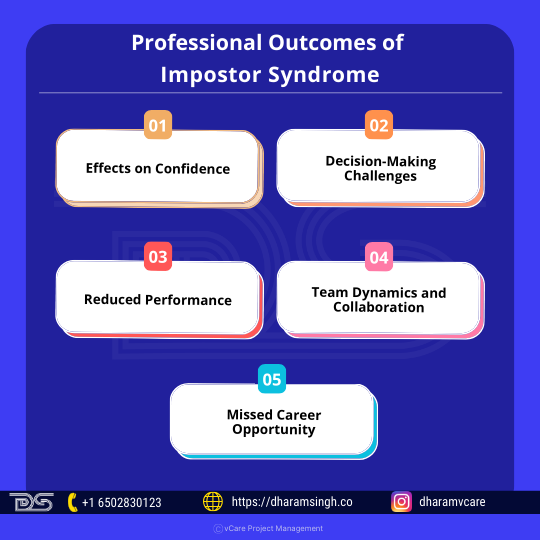
Professional Outcomes of Impostor Syndrome
- Effects on Confidence
Impostor syndrome consumes self-confidence because the project managers start doubting their decisions. For example, they may not advance new ideas in meetings, or they may deny getting credit for the success. Lack of confidence also makes leadership hard to achieve because other team members look up for direction and reassurance to their manager.
- Decision-Making Challenges
Decision paralysis is often the result of the fear of making mistakes. Project managers may delay critical decisions, seeking excessive validation or overanalyzing data to avoid potential criticism. Alternatively, they may make overly cautious decisions that limit the project’s potential, prioritizing “safe” outcomes over innovative solutions.
- Reduced Performance
Over-preparation and perfectionism, which are prominent signs of impostor syndrome, can deplete time and energy that could be better spent on strategic goals. For example, a project manager may spend hours preparing a presentation slide rather than addressing a serious resource allocation issue.
- Team Dynamics and Collaboration
Impostor syndrome can damage team trust and morale. When project managers fail to distribute duties because they lack confidence in their leadership, team members may experience micromanagement, inefficiency, and frustration. Too critical of themselves as managers create impossible goals for a team. Pressure is also unnecessary and not productive.
- Missed Career Opportunity
Those affected by impostor syndrome feel incapable of becoming leaders or take risky projects where they would appear less prepared, or they were not competent enough. The career of such a person will reach a stagnating state, while their profile is dropped lower in an organization than deserved; they already have all the skills and expertise.
To break out of the emotional and professional impacts of impostor syndrome, project managers can use strategies that include:
- Become more mindful of yourself: Recognize and acknowledge the existence of impostor syndrome symptoms.
- Reframe negative thoughts: Adopt a development attitude, which views failures as teaching opportunities, in place of a self-doubting perspective.
- Seek mentorship: Spend time with mentors or peers who could guide, support, and give critical feedback.
- Celebrating Achievements: Find time to reflect on and appreciate successes regardless of the magnitude.
Addressing the emotional and professional toll of impostor syndrome in project managers can only make the manager perform better while building healthier, more productive team dynamics. Recognizing self-doubt as an ordinary rather than failing on personal levels is the first step toward overcoming its effects.
Root Causes: Triggers in High-Stakes Environments
Impostor syndrome seems to come out of the blue. It is often caused by characteristics prevalent in competitive situations such as project, program, and portfolio management. The factors that lead to these triggers shed light on why impostor syndrome occurs and how it can be effectively managed.
Factors that contribute to impostor syndrome in highly competitive industries
- High expectations and pressure to perform
Highly competitive industries require a high level of performance under time pressure and innovation. Project managers are often faced with strict performance requirements that leave no room for error.
- Technological aspects
In areas such as technology or finance, the increasing need to keep up with the latest tools, trends, and methods threatens even experienced professionals with obsolescence and under-qualification.
- Complexity of stakeholder relationships
The need to oversee multiple stakeholders with conflicting interests exacerbates this problem. To win over stakeholders, project managers often have to “prove” themselves repeatedly.
This problem is particularly prevalent in matrix organizations where project managers need to communicate simultaneously with senior executives, cross-functional teams, and external suppliers.
- Stereotypes and systemic biases
Women, minorities, and other disadvantaged groups in leadership positions may find it more difficult to overcome impostor syndrome due to systemic biases and preconceived conceptions.
- Cultural norms
In certain cultures, humility and respect for authority are more important than self-promotion. Individuals from these backgrounds may struggle to accept their accomplishments, leading to feelings of inadequacy.
How organizational culture and dynamics exacerbate Impostor Syndrome?
- Lack of recognition and feedback
In organizations where there is little recognition of success or feedback, project managers can begin to question their usefulness and competence. A culture where only performance is measured and not individual contribution can lead to employees becoming replaceable parts rather than valued team members.
- Unhealthy competitiveness
An overly competitive environment encourages individuals to compete with and even against their peers, fostering a zero-sum worldview. In cases where promotions or bonuses are limited, the pressure to outperform others leads to anxiety and self-doubt about one’s abilities.
- Toxic leadership qualities
Leaders who micromanage, overly criticize, or fail to support their teams create a culture of fear and uncertainty. A project manager working in such a scenario feels that everything they do is being watched, which increases their fear of making mistakes.
- Undefined roles
Unclear roles and responsibilities can lead to impostor syndrome. For example, if expectations are not defined, professionals may feel unqualified even though they perform well. A project manager who is also entrusted with technical tasks without receiving appropriate training may feel inadequate in his or her management skills, even though he or she manages well.
- The emphasis on perfectionism
Organizations that reward perfection and punish mistakes create a culture where mistakes are feared. Project managers would overwork themselves or be afraid to let go because they feel that any mistake would affect their performance.
Real-world example: impact of organizational culture
- Scenario: A company transitioning to agile methods puts a lot of pressure on its managers to adapt quickly and deliver fast.
- Trigger: Most training courses offer little practical support or mentoring to prepare project managers for these tasks.
- Result: Many managers feel unable to lead agile teams, despite having relevant knowledge and experience from traditional project management.
- Exacerbation: Poor, unhelpful early iterations offer little constructive feedback and perpetuate these feelings, often increasing stress and reducing productivity.
When the company introduced a coaching system with continuous guidance from experienced Agile practitioners, managers gained more confidence in their roles, and project results improved.
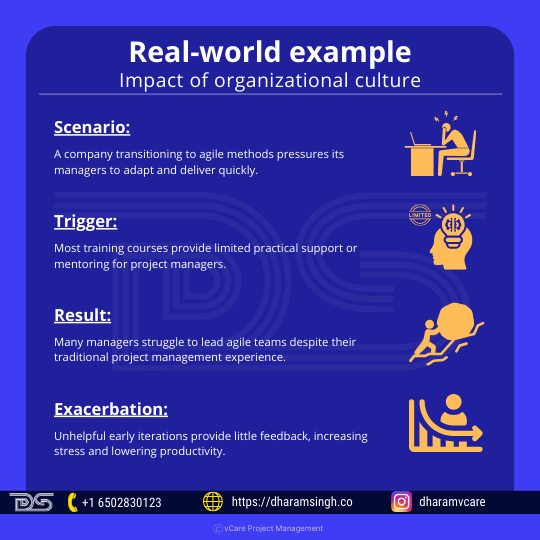
Real-world example: impact of organizational culture
Overcoming the triggers
Organizations and individuals can overcome these triggers by creating a supportive and inclusive environment:
- Encourage continuous learning
Set up training programs and professional development activities to help project managers learn the ever-changing needs of the industry.
- Recognition and feedback
This can be encouraged through a culture of regular constructive feedback and celebration of individual and team achievements.
- Develop an inclusive leadership culture:
Leaders need to be trained to make teams feel safe, heard, and valued.
- Roles and expectations
Ensure that project leaders know what is expected of them and how many resources they have at their disposal.
- Redefining failure
Change the organization’s mindset by no longer viewing failure as a symbol of weakness but as an opportunity to learn.
This understanding of the origin of impostor syndrome in a pressured setting benefits the organization. They can assist project managers overcome self-doubt, but they also foster a culture of resilience, innovation, and collaboration.
Striking the Balance: Confidence and a Growth Mindset
Project managers who struggle with impostor syndrome must strike a balance between confidence and a growth mindset. A growth mindset promotes ongoing learning and development, while confidence gives you the certainty to act. Professionals can embrace difficulties, grow from failures, and perform well under pressure when these qualities are combined.
Fostering a Growth Mindset While Maintaining Confidence
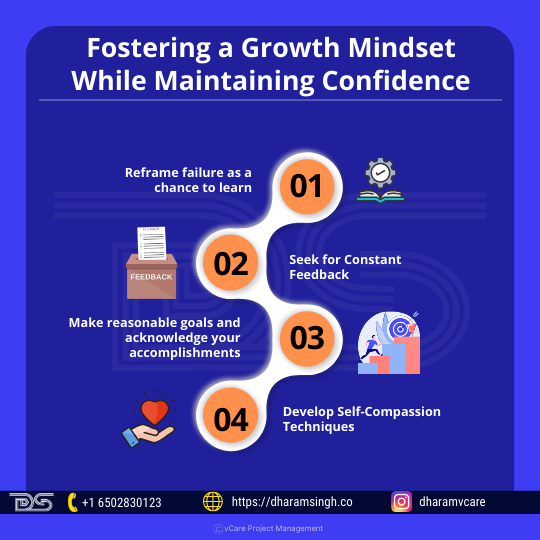
Fostering a Growth Mindset While Maintaining Confidence
- Reframe failure as a chance to learn
A growth mindset considers challenges and failures as opportunities for progress. Team members and leaders may help normalize failure by examining what went wrong and using it to guide future choices. For instance, instead of concentrating only on bad results, project managers might emphasize lessons learned from mistakes during post-project reviews.
- Seek for Constant Feedback
Frequent feedback promotes progress by pointing out blind spots and areas that need work. However, positive reinforcement increases self-esteem by recognizing achievements.
Establish organized feedback loops in teams, such as 360-degree reviews or weekly check-ins, to balance appreciation and constructive criticism.
- Make reasonable goals and acknowledge your accomplishments
Confidence can be damaged by unrealistic goals, particularly when they don’t yield the desired outcomes. Establishing modest objectives gives one a sense of achievement and increases self-confidence. For example: Break major project goals into more manageable, quantifiable tasks, then celebrate when they are finished.
- Develop Self-Compassion Techniques
People who suffer from impostor syndrome frequently criticize themselves severely. A kinder, more encouraging approach to personal growth is made possible by engaging in self-compassion practices.
To combat negative self-talk and keep perspective on failures, employ mindfulness techniques or affirmations.
Turning Impostor Syndrome into a Driver for Improvement
- Recognize Inspiring Impostor Thoughts
Instead of stifling self-doubt, take it as a lesson to be well-prepared and to aim for perfection. For instance, a project manager can focus their efforts on learning more, improving their skills, or looking for mentoring if they feel unqualified for a position.
- Prioritize learning and effort above results
The process is more important to a growth mindset than the outcome. Fear of failure declines when attention is directed toward one’s work and growth. For instance, a manager might concentrate on how much their team has developed or changed over the project rather than focusing on achieving all KPIs.
- Stress Collaborative Development
Project managers may establish cooperative, encouraging workplaces by cultivating empathy for others’ hardships through impostor syndrome. To build trust and promote group problem-solving, share personal experiences of uncertainty with team members.
- Take on Perfectionism
Impostor syndrome is significantly influenced by perfectionism. Professionals can achieve more sustained growth by adopting a “progress over perfection” mindset instead of a “perfect or bust” one. For example: To feel successful, celebrate small achievements along the way rather than waiting for a perfect end product.
Balancing confidence with a growth attitude enables project managers to change impostor syndrome from a limiting understanding to a success driver. Organizations may help individuals reach their full potential by creating a supportive culture that promotes development, learning, and empathy.
Real-World Insights: Overcoming Impostor Syndrome
Important things to know about project management tend to come out when doing the job. Impostor phenomenon as it is known does seem to fit the bill of an occupational hazard. Project managers at times end up working at cross purposes when they want to comply with expectations. This is all driven by a deep-seated belief that does not recognize that it is normal to have uncertainties and that a project manager has to have a complete understanding of every situation.
To manage project management impostor syndrome, it is suggested to raise the level of self-awareness, use ideas from the group, view themselves as team buffered, and appreciate learning. In the course of project management, there has to be an inherent contradiction between having confidence in the outcome and being modest, as well as being accepting, being prepared to learn, and pointing out achievement. This in the end builds trust and corrects behaviour in such a way that encourages rather than alienates others.
Project managers may prevent impostor syndrome by adopting a growth mindset, which allows them to refine their risk management strategy and see mistakes as opportunities for learning. One can be confident that self-doubt is a normal occurrence by networking with other project managers through organizations like the Project Management Institute. Acknowledging achievements builds confidence and momentum. Overcoming impostor syndrome is a continuous process of discovery of oneself and growth that transforms the condition into a chance for resilience and confidence.
Success Stories: Professionals Who Overcame Impostor Syndrome
Impostor syndrome is a common thing among successful people, a feeling that their achievements were not merited and they got lucky instead of being brilliant. However, many of them have defeated this insecurity and rocked their careers.
- Sheryl Sandberg – American technology executive, philanthropist, and writer
Sandberg overcame impostor syndrome by opening up about her feelings, seeking support from mentors, and taking on new challenges.
- Maya Angelou – American memoirist, poet, and civil rights activist
The poet and activist reminded herself of her worth and contributions to combat impostor syndrome. She wrote about her struggles in her autobiographies.
- Howard Schultz – American businessman and author
Schultz embraced failure as a learning opportunity, the former CEO of Starbucks.
- Runali Maniya, SDG Impactors Founder and Master of Business alumnus
The business owner started SDG Impactors, a t-shirt brand that promotes the Sustainable Development Goals of the UN. She encourages others to persevere and be strong.
- Katie Padgett Brown – Dance Educator
The artist and educator believes that overcoming impostor syndrome is a continual challenge.
- Nam Ahuja – The Senior Practice Manager at CDW
She found that being curious, asking questions, and listening helped her put aside insecurities.
Impostor syndrome is a thought pattern where someone has a persistent fear of being exposed as a fraud. It can make people doubt or minimize their accomplishments.
Lessons from Addressing Self-Doubt in Challenging Projects
Real-world projects can involve a great deal of pressure, especially when the risks are high. Impostor syndrome thrives in such environments. However, experts have offered transforming insights from their experiences.
Impostor Syndrome in Real-World Projects
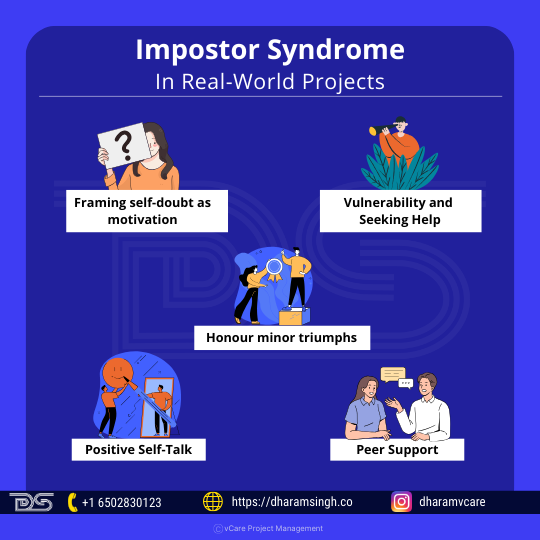
Impostor Syndrome in Real-World Projects
- Framing self-doubt as motivation: Using one’s self-doubt to increase motivation for job performance and preparation.
- Vulnerability and Seeking Help: Seek help in changing the story of impostor syndrome.
- Honour minor triumphs: Divide large objectives into small steps to promote steady progress and self-assurance.
- Positive Self-Talk: Transitioning from self-deprecation to self-support.
- Peer Support: You can become less isolated and more understanding by speaking with others who have gone through the same thing.
Key Tactics for Overcoming Impostor Syndrome
- Recognize and categorize thoughts to detect impostor syndrome.
- Maintain a success journal to document accomplishments.
- Reframe failure as learning opportunities.
- Establish a growth mindset to shift from fixed to improvement-oriented.
- Seek mentorship for insight, encouragement, and constructive criticism.
Cultivating Resilience: The ‘Refuse to Lose’ Mentality
One of the most sought-after and essential traits in the fast-paced workplace of today is resilience. Professional competence in showcasing quicker adaption results in “refusing to lose” mindset in the face of adversity. Resilience is often top-driven with intentional and persistent efforts and the organization’s culture in accepting the change to sustain and overcome hurdles while focusing on long-term success.
The “refuse to lose” mentality implies an unwavering will to achieve one’s goals despite setbacks. It is distinguished by a mindset that sees problems as chances for progress and failures as temporary obstacles rather than insurmountable barriers. This mentality does not mean a steadfast rejection to accept failure, but rather a reluctance to let it define one’s journey. People with this mindset use a proactive, problem-solving attitude, modifying their techniques while remaining focused on their goals. This approach is crucial for professionals in leadership positions including project managers, entrepreneurs, and team leaders. It builds confidence, motivates teamwork, and allows people to manage challenging circumstances with clarity and resolve.
Developing a Resilient Mindset
- Accept failure as a learning experience
Resilience individuals view failure as a learning opportunity, reducing anxiety and promoting continuous progress, thereby transforming it into a stepping stone for success.
- Practice emotional regulation
Emotions need to be handled in a professional manner under stressful conditions. Identifying, understanding, and controlling emotions to respond positively is the essence of emotional regulation. For example, a leader confronted with a project delay may first experience annoyance or fear. Instead of responding impulsively, individuals might pause, analyze the circumstance, and take sensible action to resolve the problem. This calm approach not only helps to address problems but also sets a good example for the team.
- Concentrate on incremental progress
Breaking down big goals into smaller, easier-to-accomplish chores might help you feel more in control. This method generates momentum and confidence, allowing individuals and teams to concentrate on making steady progress. For example, a team working on a large-scale product launch might establish goals for each phase and celebrate little success along the way. Incremental achievement fosters the idea that the final objective is feasible.
- Create a Reliable Support Network
A strong support system can frequently help to boost resilience. It is essential to surround oneself with coworkers, mentors, or peers who can offer direction, support, and critical comments. When leaders encourage cooperation and support among their teams, they create an environment in which resilience becomes a common value. For example, an organization founder experiencing financial issues may seek strategic assistance from their advisory board, building on their aggregate knowledge and expertise.
- Adopt a growth mindset
Professional competence with experience, is essential for fostering resilience. This mentality encourages people to see problems as chances to learn new abilities and maximize their potential. Leaders with a growth mentality encourage their staff to accept change, take measured chances, and innovate even in uncertain situations.
Inspiring Teams Through Resilience
- Manage with transparency and optimism
Resilient leaders motivate their people by combining openness about obstacles with optimism about solutions. Acknowledging obstacles but remaining confident in the team’s capacity to overcome them fosters trust and drive. For example, a project manager handling resource limits may openly address the situation with their team while showing faith in their team’s ability to solve problems together. This strategy enables the team to face difficulties straight on.
- Promote a solutions-oriented culture
A solutions-oriented culture encourages teams to consider potential rather than problems. Leaders may help their teams explore new ways and cooperate to overcome problems. For example, a logistics team dealing with supply chain problems can collaborate to find alternate suppliers or adapt delivery timetables. This method guarantees that obstacles are faced with proactive problem solutions rather than defeatism.
- Empower team members
Empowering team members to take ownership of their roles promotes responsibility and confidence. When people feel trusted to make decisions and contribute to solutions, they are more inclined to face obstacles with grit. For example, a leader who delegates decision-making authority to their team amid a crisis not only fosters trust, but also enhances the team’s capacity to adapt and persist.
- Acknowledge Success and Effort
Acknowledging minor accomplishments boosts perseverance and self-confidence. Celebrating success requires praising effort and commitment, and a team feeling valued is more likely to remain resilient and motivated amidst problems.
Resilience’s Impact on Long-Term Achievement
Resilience in the face of hardship is all about limiting the damage and being able to swiftly resume routine. Long-term success in any field requires a culture of change acceptance, which resilience promotes.
Resilience as a Path to Success
Cultivating a “refuse to lose” mindset is critical for overcoming challenges and establishing lasting success. Individuals may acquire the resilience required to confidently manage obstacles by viewing failure as a learning opportunity, exercising emotional regulation, and having a growth attitude. Leaders who exemplify and promote resilience motivate their colleagues to continue, creating an environment of hope and resolve. Finally, resilience is not about avoiding obstacles, but about growing stronger with each one, ensuring that neither individuals nor teams lose sight of their ability to achieve.
Authenticity over Pretence: Beyond ‘Fake It till You Make It’
The “fake it till you make it” tactic, on the other hand, creates short-term confidence under challenging conditions but has long-term risks. In contrast, the “original” method makes one rely on long-term confidence and trust and gives the same person effective leadership. The strategy is better compared to the latter for counteracting impostor syndrome.
Examining the Limitations of ‘Fake It Till You Make It’
- Superficial Confidence and Emotional Burnout
“Faking it” frequently results in a reliance on external validation rather than actual self-confidence. Over time, the strain to maintain a front can lead to emotional depletion and worsen impostor syndrome.
According to Frontiers on Burnout and Remote Work Stress study published in Psychological Bulletin, hiding actual sentiments or actions to fit into work situations frequently leads to stress and poor job satisfaction.
- Loss of trust in leadership
Leaders who use a “fake it” strategy may fail to develop true relationships with their employees. Trust is the foundation of effective leadership, and perceived inauthenticity can undermine trust. According to Harvard Business Review study: How Transparent Should You Be with Your Team, employees are more inclined to interact with executives who are vulnerable and transparent than those who are too polished or fake.
- Missed Opportunity for Growth
Pretending to know everything may prevent people from seeking help or realizing that they need to improve, which will hinder personal and professional development. A Forbes study on leadership characteristics found that knowledge gaps encourage collaborative problem-solving and foster a culture of continuous learning.
Promoting Authenticity as a Key to Sustainable Leadership
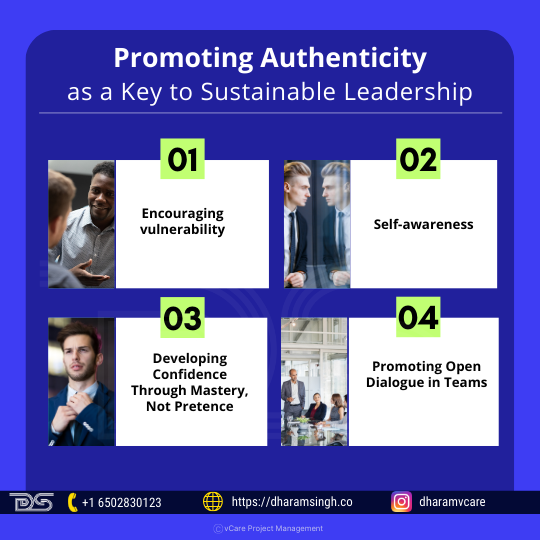
Promoting Authenticity as a Key to Sustainable Leadership
- Encouraging vulnerability
Authentic leaders are open about their shortcomings and share their learning processes with their people. Vulnerability humanizes leaders, resulting in stronger ties and greater respect.
- Self-awareness
Professionals can improve their self-understanding through strategies such as self-reflection or 360-degree feedback, which require self-awareness and acceptance of both personal strengths and weaknesses.
- Developing Confidence Through Mastery, Not Pretence
Authentic confidence is generated via technical mastery and actual successes, not a superficial display of ability. This method guarantees that confidence remains resilient under pressure.
- Promoting Open Dialogue in Teams
Leaders who value authenticity may encourage their people to communicate ideas and concerns without fear of being judged. This fosters a culture of psychological safety, increasing creativity and productivity.
While “fake it till you make it” might provide brief comfort from self-doubt, its drawbacks frequently exceed its advantages. Authenticity, from awareness and vulnerability to honest self-confidence, is much better support for sustainable growth into professionals and effective leaders. A leader who owns his true identity also eliminates impostor syndrome in his life and inspires their teammates with trust, loyalty, and innovation.
The Silver Lining: Impostor Syndrome and Team Dynamics
Unexpected advantages that may enhance workplace dynamics are offered by impostor syndrome, though it is frequently perceived as an unpleasant experience. For individuals suffering from impostor syndrome, interpersonal connections can be improved and contributory roles to cohesive, high-performing teams can be accomplished through the cultivation of self-awareness, empathy, and a collaborative mentality. This viewpoint changes the narrative, emphasizing how impostor qualities may generate unique chances for team growth and success.
How Impostor Syndrome Promotes Collaboration and Empathy?
- Increased Empathy by Sharing Vulnerabilities
Individuals suffering from impostor syndrome are frequently acutely aware of their hardships, which makes them more sympathetic to the difficulties of others. This increased sensitivity promotes a friendly workplace atmosphere.
According to Frontiers: Organizational Psychology, leaders who freely admitted their fears were more likely to foster trust and boost team morale. Teams led by compassionate people expressed greater levels of pleasure and engagement.
- Promoting Inclusion and Diverse Perspectives
Impostor syndrome can make people more open to comments and suggestions from their coworkers. This transparency promotes inclusion and different contributions within teams. McKinsey & Company study on Psychological Safety shows that psychological safety, which is typically associated with empathy and vulnerability, has a favorable influence on innovation and problem-solving in diverse teams.
- Developing a Culture of Continuous Learning
People with impostor syndrome frequently want to improve themselves via continual learning. When incorporated into teams, this approach may foster a culture of self-improvement and skill development.
According to a Harvard Business Review article on “Growth Mindset”, leaders who embrace a growth mindset inspire their staff to follow accordingly, resulting in long-term team success.
Using Empathy and Collaboration for Team Cohesion
- Establishing Psychological Safety
A culture where expressing self-doubt is viewed as a learning opportunity rather than a sign of weakness may be established by team members and leaders.
- Promoting cooperative problem-solving techniques
Self-doubt is the characteristic aspect of impostor syndrome, driving people to seek feedback from others frequently. This can naturally result in more collaborative problem-solving and sound decision-making being made.
- Creating stronger team bonds
Shared experiences with impostor syndrome can bring team members closer together and promote unity. Teams that bond over common struggles are frequently more cohesive and resilient.
Impostor syndrome, while hard, provides unique chances to improve workplace relationships via enhanced empathy, collaboration, and a desire to learn. Leaders may use psychological safety to establish cohesive and resilient teams. Turning impostor syndrome’s perceived “weakness” into a strength benefits both people and the company as a whole.
Support Systems: Mentorship, Leadership, and Organizational Roles
Impostor syndrome thrives in circumstances that lack proper support, making mentorship and leadership critical in resolving this common issue. Organizations that use defined frameworks to actively foster confidence and progress might turn impostor syndrome into a professional development opportunity.
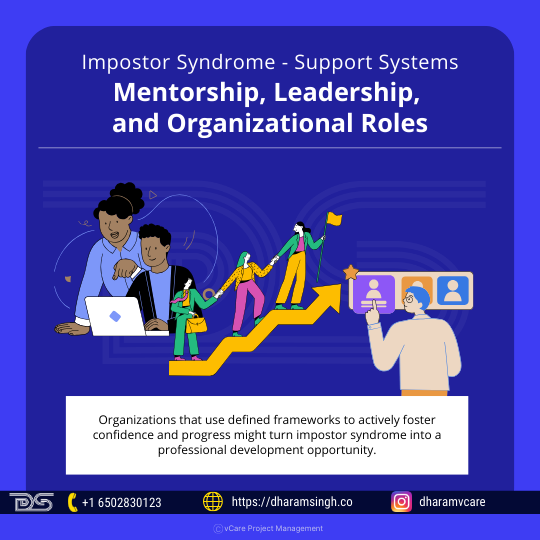
Impostor Syndrome – Support Systems: Mentorship, Leadership, and Organizational Roles
The role of mentorship and leadership
- Assistance with mentoring as a catalyst for confidence
Mentors provide a secure environment for mentees to discuss their fears and acquire perspective.
The Harvard Business Review emphasizes the value of mentors who aggressively confront negative self-talk and assist mentees in recognizing their accomplishments.
- Leadership Styles That Prevent Impostor Syndrome
Transformational leaders, who inspire and motivate by creating psychological safety, are very good at addressing impostor syndrome.
Developing organizational frameworks for confidence and growth
- Transparent Feedback Systems
Constructive, actionable criticism encourages employees to see mistakes as learning opportunities rather than failures.
- Inclusive and supportive cultures
Inclusivity training and DEI (Diversity, Equity, and Inclusion) activities create an atmosphere in which employees feel valued for their individual contributions.
A Deloitte survey found that firms with effective DEI frameworks have greater employee satisfaction and lower instances of impostor syndrome.
Future Directions: Addressing Impostor Syndrome in an Evolving Workplace
As workplaces evolve, businesses must develop methods to handle the shifting environment of impostor syndrome, which is impacted by hybrid work arrangements and developing technology.
Hybrid Work Models and their Impact
- Remote Work: A Double-edged Sword
While remote work provides flexibility, it can also exacerbate feelings of isolation and self-doubt owing to decreased visibility and acknowledgment. A Buffer: State Of Remote Work 2023 poll on remote work found that 20% of remote workers felt detached from their teams, aggravating impostor emotions.
- Leveraging Technology for Inclusion
When utilized properly, virtual platforms such as Slack and Zoom may promote improved team communication and cooperation.
Tools like as 360-degree feedback systems also enable remote workers to obtain continuous recognition for their achievements, eliminating impostor tendencies.
Future Directions: Addressing Impostor Syndrome in the Evolving Workplace
Organizations have additional hurdles in dealing with impostor syndrome as workplaces shift due to hybrid models and technology improvements. The changing nature of work, marked by distant cooperation, digital advancements, and changed employee expectations, needs proactive methods to reducing self-doubt and creating a supportive atmosphere.
How hybrid work models influence impostor syndrome?
- Remote Work Amplifies Isolation
Hybrid work models can increase impostor syndrome by amplifying isolation, lack of visibility, and limited feedback loops. Remote workers often feel that their efforts are not recognized, which increases self-doubt. According to a Buffer: State Of Remote Work 2023 study, 20% of remote workers experience loneliness, and 14% face communication challenges, which are exacerbated by remote work.
- Challenges in Building Team Cohesion
Hybrid teams face challenges in collaboration opportunities, leading to remote members feeling undervalued. A 2022 Microsoft Work Trend Index report revealed that while 58% of employees thrive in hybrid environments, others struggle to demonstrate their value.
- Opportunities for Flexibility and Personal Growth
Hybrid work provides employees with flexibility, allowing them to work at their own pace, reducing stress and promoting a positive work-life balance, as evidenced by Gallup’s 2022 data.
The Impact of Technology on Impostor Syndrome
- Digital Tools for Recognition and Feedback
Technology can assist overcome communication gaps in mixed work environments by enabling real-time recognition and constructive feedback. Managers may use tools such as Slack, Microsoft Teams, and Culture Amp to recognize employee successes and address problems on a regular basis.
- Overwhelming Pace of Digital Change
The rapid expansion of digital technologies can overwhelm employees, especially those who believe they lack the necessary qualifications to stay up, increasing impostor syndrome. Professionals are increasingly concerned about job displacement and inadequacy as their dependence on artificial intelligence and automation grows.
Preparing Organizations and Individuals Ready for Future Challenges
Organizations should create inclusive hybrid work environments, ensuring equity in opportunities, feedback, and recognition for both in-office and remote employees. Implementing hybrid-friendly policies and prioritizing inclusive collaboration tools can help. Employee well-being investment, including mental health support and resilience training, can be a great way to fight impostor syndrome.
Leadership development for a changing workforce is also very important, with programs like Adobe’s “Check-In,” which encourages managers to hold monthly feedback sessions. Leverage technology for personalized growth, such as AI-driven career development tools, that help identify skill gaps and tailor learning experiences. Virtual reality training programs will become a future trend in building confidence and reducing feelings of inadequacy.
Hybrid work poses both challenges (e.g., isolation) and opportunities (e.g., flexibility), which influences impostor syndrome. Technology may both exacerbate self-doubt and provide instruments for feedback, acknowledgment, and skill growth. Organizations must use inclusive practices, mental health programs, and new technology to prepare people for future workplace dynamics.
Conclusion: Addressing the Hidden Challenge of Impostor Syndrome in Project Management
Impostor syndrome is a serious but largely silent difficulty for project management professionals working in high-pressure situations. Individuals and organizations may lessen the effects of the pandemic by recognizing its core causes, treating its psychological toll, and developing resilience tactics.
Recognizing and addressing impostor syndrome in project management
The first step toward resolution is to recognize impostor syndrome’s common impact on project managers working in high-stakes contexts. The ongoing need to manage several obligations frequently causes self-doubt, which leads to stress and poor performance. Awareness and acknowledgment of these sentiments are essential for dissolving their influence.
Balancing Confidence with Continuous Growth
To combat impostor syndrome, professionals must develop confidence and a development mentality. Confidence promotes self-assurance in decision-making, but an approach to growth allows project managers to see setbacks as chances for learning. Together, these characteristics prepare people to overcome failures with optimism and tenacity, eventually encouraging personal and team success.
Leveraging Real-World Strategies and Resilience
Real-world instances show that impostor syndrome may be successfully addressed with purposeful effort. Resilience, shown as a “refuse to lose” mindset, enables professionals to persevere in the face of adversity. This mindset not only boosts individual morale, but it also encourages teams to take similar approaches to problem resolution.
Promoting authentic leadership
The era of “fake it till you make it” has demonstrated its limitations. The key to long-term success is sincerity. Project managers may strengthen their teams’ connections by accepting vulnerability and concentrating on effective leadership. Authenticity also weakens impostor syndrome by relieving the urge to present perfection and allowing individuals to lead with integrity.
Impostor Syndrome’s Impact on Team Dynamics
Interestingly, impostor syndrome can have a positive outcome. When correctly addressed, it promotes empathy and collaboration, which enhance team interactions. Leaders and team members who freely communicate their difficulties with self-doubt foster a culture of mutual support and understanding, which improves team cohesiveness and productivity.
The Value of Support Systems and Organizational Roles
Mentorship and empathetic leadership are critical in overcoming impostor syndrome. Mentors help professionals overcome self-doubt, whereas leaders foster an environment of psychological safety. Organizations, too, contribute by establishing systems that promote open communication, frequent feedback, and opportunity for advancement.
Looking Forward: Adapting to a Changing Workplace
As hybrid work patterns and technology breakthroughs transform workplaces, impostor syndrome gains new dimensions. Remote setups may increase isolation, and fast technical advancements can foster feelings of inadequacy. To better prepare individuals for future challenges, forward-thinking firms must embrace inclusive policies, leverage technology for development, and prioritize mental health support.
Empowering Project Managers for Success
Impostor syndrome is not a hurdle, but rather a hidden difficulty that, when handled, may unleash immense potential. Using self-awareness, resilience, honesty, and organized support, project managers may overcome self-doubt and lead confidently. At the corporate level, cultivating an inclusive and continuous growth culture guarantees that workers survive and, more importantly, thrive in their positions. These concepts form a solid basis for long-term success in project, program, and portfolio management.

by Dharam CW2 | Dec 13, 2024 | Industry Trends and Insights
Digital transformation is a strategy that modernizes business processes and introduces new services to engage customers, support employees, improve operations, and drive business value. PwC’s 27th Annual Global CEO Survey shows a growing need for transformation, with 70% of CEOs making changes in value creation, delivery, and capture over the past five years. IBM’s 2024 CEO Study reveals high pressure on executives to transform, with 72% viewing industry disruption as a risk rather than an opportunity. A business-centric approach to modernizing organizations through digital technologies is crucial for long-term business survival. Organizations must reinvent their operations and business models in the modern era, integrating digital technologies into all aspects to improve products and services, streamline processes, and introduce new revenue streams.
The global market for digital transformation technology and services is expected to reach $3.9 trillion by 2027, despite 70% of projects failing to meet objectives. To avoid falling into the 70% failure rate, organizations must make the right investments and adopt reversed leadership to foster resilience.
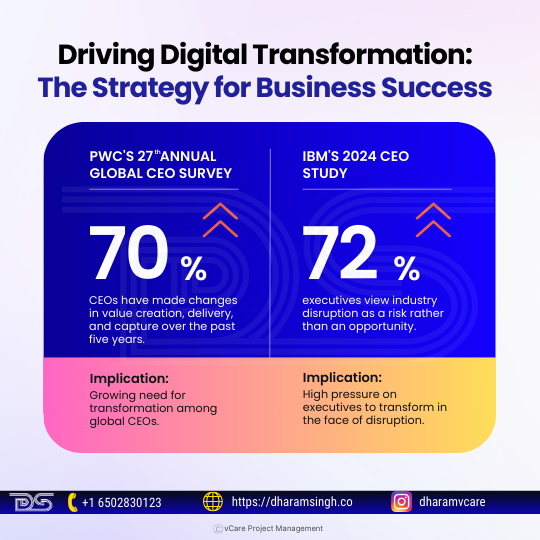
Driving Digital transformation
Peter Drucker’s theory emphasizes inverted leadership in businesses to promote resilience. He argues that the biggest danger in instability is not the turbulence itself, but acting on outdated thinking. To address this, companies must reject outdated methods and create adaptive structures that welcome change.
In today’s competitive environment, the Transformation Management Office (TMO) is critical for driving progress, building a value proposition, and providing comprehensive transformation guidance.
What Sets TMOs Apart?
The Transformation Management Organization (TMO) is a vital structure that oversees the planning, management, and monitoring of transformation activities. It unites diverse teams, driving accountability and clear direction. It serves as the link between strategy and implementation, ensuring the successful execution of a transformation initiative. The TMO’s key functions support the organization’s transformation program, making it valuable for businesses.
TMO and PMO
A Project Management Office (PMO) supervises specific projects inside a business, but a Transformation Management Office (TMO) controls the overall transformation path, which includes various projects and initiatives. A PMO manages project-specific goals, schedules, and resources to ensure timely and cost-effective completion.

TMO and PMO
Key differences include:
- Scope: TMOs manage large-scale changes involving several interconnected projects, whereas PMOs focus on a group of individual projects.
- Duration: TMOs are transient entities that dissolve during transformation, but PMOs can become permanent fixtures within an organization.
Transformation Management Office Importance:
- Aligns the company’s transformation plan with business goals.
- Provides control and monitoring in decision-making and risk management.
- Effectively manages organizational change, involves stakeholders, and promotes new procedures.
- Monitors and measures transformation progress to ensure expected benefits and ROI.
- Acts as a focal point for organizing activities and ensuring coordination across departments.
Bridging the Gap Between Expectation and Reality
Digital transformation is a major strategic objective for organizations, necessitating a fundamental shift in operations, customer interaction, and value delivery. This shift affects all parts of a company, from business model to culture, and necessitates extensive change management. Navigating these obstacles is critical for firms to adapt and succeed in the digital era. Change management involves preparing individuals and teams to adapt, often facing resistance, misunderstanding, and fear in large, fast-paced digital transformations. Understanding potential challenges can help organizations navigate this complexity efficiently. Strategic planning, effective change management, and a strong understanding of these challenges can position businesses for long-term success in the digital era.
Digital Transformation Challenges to Overcome
Digital transformation offers innovative opportunities for organizations but also necessitates critical thinking and reimagining core business aspects. Regardless of industry, from manufacturing to pharma, a few key challenges to consider when implementing digital transformation projects in 2024 include:
- Absence of a change management plan
A well-structured change management strategy significantly boosts digital transformation success, involving identifying root causes and building relationships with stakeholders and employees, thereby reducing the likelihood of project failure.
- Complex software and technology
Organizations undergoing digital transformation face challenges in complex enterprise software, data integration, and end-user experience.
- Driving the uptake of new tools and procedures
Organizations must provide comprehensive on boarding training and continuous performance support for new software implementations to help employees become productive and proficient with the new processes, overcoming resistance from tenured employees.
- Lack of a digital transformation strategy
Before implementing a digital transformation process, it’s crucial to understand the reasons for replacing legacy systems, the organization’s plan for advanced systems, and the readiness to migrate existing systems. Choose from various models based on improvement areas and company needs.
- Lack of proper IT skills
A tech worker shortage is impeding firms’ digital transformation efforts, with 54% claiming a lack of technically qualified employees. Cybersecurity, application architecture, software integrations, data analytics, and migration are all challenges that must be addressed by either outsourced or in-house teams.
- Security concerns
Enterprise organizations in data-sensitive industries face privacy and cybersecurity concerns due to digital transformation, which involves integrating data into a centralized system. Cyberattacks can target system vulnerabilities and poor setups, necessitating proactive mitigation plans and cybersecurity training for employees.
- Budget constraints
Digital transformation is a costly investment, with scope creep, consultation work, customer changes, and IT errors increasing costs. To manage this, organizations should identify long-term goals and ROI, determining what spending is too much and budget room for budget increase.
- Poor organizational structure
Organizational isolation can hinder collaboration, communication, resource allocation, and innovation in digital transformation initiatives, affecting decision-making and the flow of ideas.
- Measuring ROI
Since the advantages of projects involving digital transformation cannot be immediately perceived or measurable, calculating return on investment (ROI) can be difficult. Progress may be impeded as a result of uncertainty and a failure to invest in future projects.
Tips to Overcome Digital Transformation Challenges
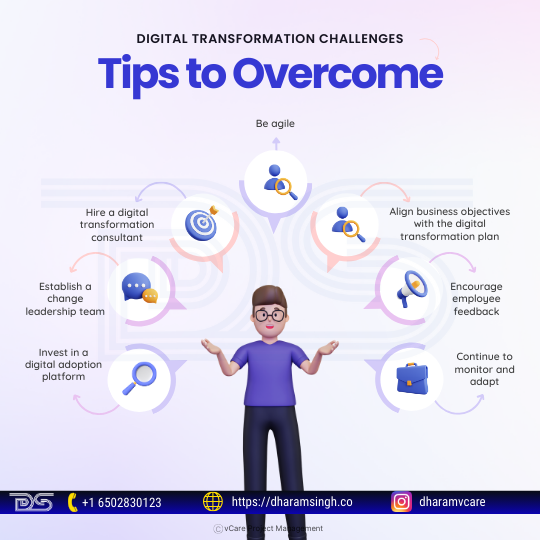
Tips to Overcome Digital Transformation Challenges
- Invest in a digital adoption platform
Investing in a digital adoption platform (DAP) is vital for successful digital transformation projects, as it provides adequate on boarding, training, and support for employees.
- Establish a change leadership team
Identify influential, innovative, and trustworthy employees in your workforce and form a cross-functional change leadership team to create a vision for digital transformation aligned with business goals, allowing organizations to take a proactive approach and accelerate change.
- Hire a digital transformation consultant
Digital transformation involves realigning core processes, tools, and experiences, often challenging organizations with a lack of internal change agents. Hiring a digital transformation consulting company offers a proven framework and success-based framework for successful change.
- Align business objectives with the digital transformation plan
An organization’s digital transformation should prioritize understanding customer needs, pain points, and friction areas in offerings, products, and services. Analyse current processes to identify outdated systems and align with core business goals, empowering employees, overcoming customer experience challenges, and driving revenue.
- Be agile
Digital transformation projects require organizational vulnerability, as leaders must adapt and innovate in a rapidly changing technology landscape. Being agile means pivoting and seizing opportunities, and embracing new processes, tools, and practices, even if they’re already underway.
- Encourage employee feedback
Employee involvement in digital transformation can help organizations overcome challenges by involving them in decision-making, identifying obstacles, and devising effective solutions, fostering a sense of ownership and accelerating the success of digital transformation initiatives.
- Continue to monitor and adapt
For real-time changes, alignment with corporate objectives, efficient resource allocation, and resolving possible problems before they become worse, it is essential to continuously monitor, measure, and evaluate digital transformation projects.
Leadership in Transformation: The CTO’s Role
According to the PwC CEO Survey, 22% of UK CEOs are predicting their current business model will not last for the next decade due to changing consumer and regulatory needs, talent shortages, climate, digitalization, economy, and geopolitics. This necessitates immediate changes in the supply chain, operational model, product portfolio, strategy, and culture.
The growth of strategic leadership skills among Chief Transformation Officers (CTOs)
Transformation is crucial for organizations, but there is no clear leader. Three approaches exist: top-down, devolved, and dedicated.
- Top-down involves the CEO leading, and delegating to C-Suite colleagues, while devolved involves other C-Suite members rotating.
- The devolved approach involves other C-Suite members, potentially on rotation.
- The third approach involves a dedicated individual focused on developing and delivering the transformation strategy.
The need for a dedicated transformation leader depends on the scale, complexity, and ambition of the strategy. As transformation becomes ‘business as usual’, organizations are increasingly creating board or C-suite roles like transformation director or Chief Transformation Officer.
The demand for a dedicated and elevated transformation leader
A transformation leader is responsible for driving an organization’s change ambitions, elevating them to the top, and ensuring transformation remains a key agenda item. They must set the tone, challenge current wisdom, and integrate functional and organizational priorities like sustainability, purpose, and digital transformation to create a viable future. The leader’s role involves gathering insights, identifying change impetus, devising a vision, and designing key steps.
Top leadership skills for a CTO Role

Top leadership skills for a CTO Role
- Strategic thinking
A CTO must be able to think strategically to foresee market trends, develop a strategy, communicate clearly, and compile a variety of perspectives. This skill aids with innovation, value creation, and competitiveness.
- Technical competence
A CTO must possess technical expertise, which calls for an extensive understanding of modern tools, technologies, and frameworks as well as the capacity to assess, choose, and put into practice scalable, secure, and dependable solutions.
- Team leadership
CTOs require strong team leadership skills to recruit, train, and motivate diverse teams, foster collaboration, and provide clear direction. This builds trust, engagement, and productivity, enhancing productivity.
- Business acumen
CTOs must possess business acumen in order to analyze effect, match technological solutions with business strategy, and comprehend the market, consumers, and competitors. Making informed, data-driven, and customer-focused decisions is facilitated by this ability.
- Communication skills
CTOs require strong communication skills to effectively communicate their vision, strategy, and objectives, establish rapport, credibility, and influence, and actively listen, inquire, and empathize with others.
- Learning agility
CTOs must learn agility, adapt to changing situations, learn from successes, embrace new challenges, foster a learning environment, seek knowledge, and seek feedback to grow, innovate, and improve.
How the CTO and TMO collaborate to advance organizational success?
The CTO and TMO work together to align technology strategies with enterprise-wide transformation goals, with a focus on innovation, scalable solutions, and leveraging new technologies for competitive advantage. Through advanced analytics and efficient project and change management, they maximize resources, create a balance between technical and operational requirements, and promote data-driven decision-making. Through this collaboration, technology is certain to play a significant part in transformation, fostering agility, operational effectiveness, and quantifiable results throughout the company.
Here’s how they work together in detail:
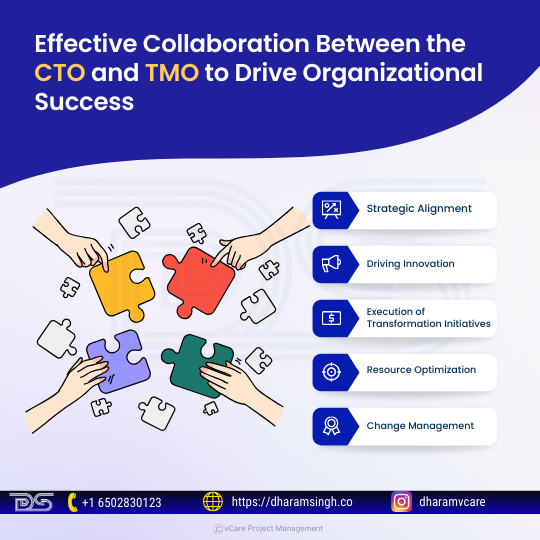
Effective collaboration between CTO and TMO
- Strategic Alignment
The CTO and TMO collaborate to develop a long-term technology roadmap, aligning IT and operational changes with the organization’s strategic vision and ensuring value.
- Driving Innovation
The CTO implements new technologies to enhance operational efficiency and customer experiences, while the TMO facilitates their integration within the organization, collaborating on technical expertise.
- Execution of Transformation Initiatives
The CTO provides tools for transformation projects, while the TMO manages them efficiently, ensuring milestones are met and the technical enablers are effectively utilized.
- Resource Optimization
In order to prevent redundancy and guarantee the economical deployment of technology and human capital, the CTO and TMO collaborate to optimize technical resources, assign resources for transformation initiatives, and work collectively.
- Change Management
The CTO manages technical challenges and resistance during technology implementation, while the TMO manages organizational resistance and ensures cultural buy-in for changes.
Building the Team Behind the Transformation
Effective digital transformation strategy requires assembling the right team, considering factors like experience, education, skillsets, influence, and teamwork abilities. Digital teams are led by C-level executives, who may hold titles like CIO, CTO, or COO, and have other responsibilities. The CEO appoints the leader for all digital transformation initiatives, based on their view of the process. Finding the right team members is a challenge in digital transformation projects.
What roles do digital transformation teams need?
Digital transformation requires nine key positions, but on average, 12-20 people are on each team, with multiple people working within each role in most companies.
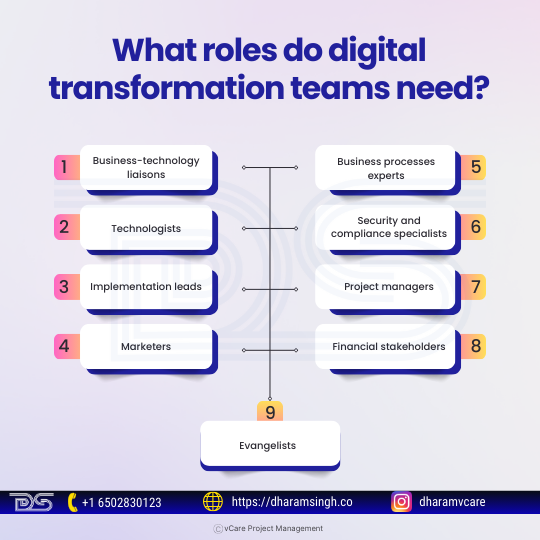
What roles do digital transformation teams need?
- Business-technology liaisons
Business technology liaisons work with business unit executives to identify opportunities and challenges by examining business models, customer experience, and technology strategy as part of initiatives to transform their businesses.
- Technologists
Technologists identify business issues for transformation, select appropriate technology and providers, and evaluate the technical success of digital transformation projects.
- Implementation leads
This role involves leading the digital transformation roadmap, focusing on technology and process change implementation, with additional daily implementations.
- Marketers
IT staff often implement new technology to enhance customer experiences, but employees often lack understanding. Marketers should understand the project’s goals, technology impact, and effective marketing strategies to engage employees, customers, and business partners, ensuring customer engagement.
- Business processes experts
Business process experts are essential for digital transformation, optimizing workflows, recommending AI, machine learning, and automation, and fostering new digital strategies for a digital-forward approach.
- Security and compliance specialists
Digital team leaders should involve security and compliance specialists from the start to avoid potential project halts due to potential security policy violations, ensuring a smoother and more secure project.
- Project managers
Project managers develop detailed plans, maintain staff, schedule, and budget, set meetings, and schedules, raise red flags, and reset expectations to ensure the project stays on track.
- Financial stakeholders
Digital transformation initiatives are financed by financial stakeholders, who also persuade other budget holders to obtain further financing. They demand weekly, monthly, or quarterly updates to monitor progress and ensure the budget is well spent. C-level executives often serve as ultimate financial stakeholders.
- Evangelists
Evangelists use their influence and communication skills to generate excitement and secure funding for projects, often through well-received internal blogs and videos, and provide honest evaluations to budget control authorities.
Ways to select the best team for a business transformation
Building a team for technology transformations requires effort, approval from supervisors, and discipline. Best practices include finding suitable individuals, ensuring discipline, and integrating them into daily tasks.

Ways to select the best team for a business transformation
- Identify the roles and skills needed
Define roles and skills for your business transformation team, including project management, change management, business analysis, technical skills, communication, and stakeholder engagement, considering their authority and responsibility, and their interaction with the organization.
- Evaluate your current talent pool
Utilize various assessment methods to evaluate your talent pool, focusing on adaptability and learning potential, and consider external recruitment for skill gaps or fresh perspectives.
- Align the team to the mission and objectives
Select team members and align them with business transformation goals. Communicate project purpose, scope, benefits, risks, organization strategy, values, expectations, accountability, measurement, reward, and resources. Provide support and training for effective performance.
- Promote a culture of collaboration and innovation
Foster a culture of collaboration and innovation within your business transformation team by encouraging open communication, experimentation, and improvement. Celebrate team achievements and milestones to select the best team for your transformation and increase the chances of achieving desired outcomes.
Speed vs. Sustainability: Achieving the Right Balance
Striking the correct balance between speed and sustainability is the primary barrier to implementing organizational change. On the one hand, it may be swiftly implemented, providing competitive advantages and results right away. On the other hand, long-term success and preventing exhaustion or inefficiency will depend on ensuring that improvements are sustainable. A transformation management office is essential in striking this delicate balance to ensure both immediate effect and long-term value.
Need for Speed in Transformation
In transformation projects, speed is typically the primary concern, particularly in settings where external pressures like market rivalry, technology disruption, or regulatory changes need quick reactions. Quick action might offer several advantages:
- First-Mover Advantage: Quick deployment can help a company surpass its rivals, increase market share, or reshape industry norms.
- Momentum and Engagement: Stakeholders are excited by quick wins, which generates momentum for more change.
- Crisis Management: Speed may be a useful reaction to stabilize operations and preserve company flow during crises like recessions or supply chain disruptions.
- Customer demands: In general, meeting evolving customer demands necessitates a quick adoption of new procedures or technology.
Yet, the need for speed comes with hazards, such as making rapid choices, failing to involve stakeholders, and putting in place short-term solutions that might not last.
The Case for Sustainability
The focus of transformation sustainability is on making adjustments to the systems, procedures, and organizational culture in a way that will yield long-term benefits. The following are some advantages of sustainable change:
- Cultural Incorporation: Because employees can adapt and adopt new behaviours, changes that take into consideration the company culture have a higher chance of success.
- Resilience: Systems and procedures that are able to adapt over time and withstand future disruptions are the result of sustainable adjustments.
- Cost-Effectiveness: While such quick adjustments may lead to waste and rework, sustainable projects are made to be as efficient as possible while maximizing return on investment.
- Establishing Stakeholder Trust: Stakeholders will remain committed and helpful if a progressive approach is taken to gain their confidence.
This approach to sustainability has the drawback of lengthening timeframes, which gives competitors a chance to outstrip them or opportunities to fall away.
How the TMO Achieves the Balance
An effective TMO makes sure that sustainability and speed are beneficial not detrimental, components of a successful transition. A TMO accomplishes this balance in the following ways:
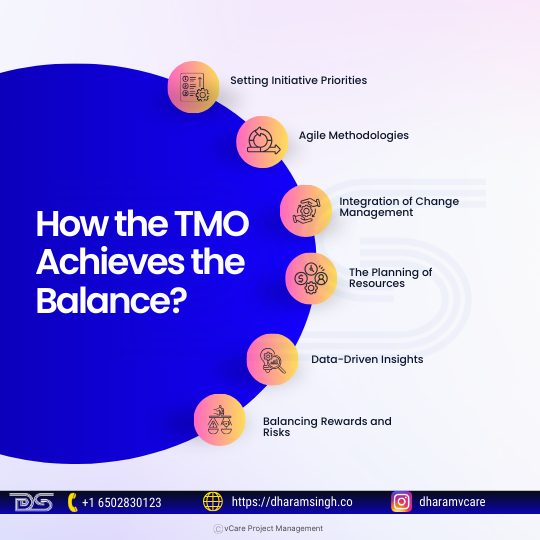
How the TMO Achieves the Balance
- Setting Initiative Priorities
Transformation initiatives undergo a thorough study by the TMO, which then classifies them based on their long-term worth and urgency. The TMO guarantees that important objectives are fulfilled without sacrificing the sustainability component by distinguishing between urgent and non-urgent initiatives that may be phased in.
- Agile Methodologies
Using agile frameworks, the TMO promotes iterative progress. In this manner, the company may provide immediate results while also gradually improving procedures in the direction of long-term goals.
- Integration of Change Management
Rapid adoption and deep integration into the organization’s culture are two goals of change management techniques implemented through the TMO. As an example:
- Short-term: Employees will be assisted in understanding the instantaneous advantages of changes through training and direct communication.
- Long-term: Constant interaction via feedback loops guarantees acceptance and embracing change.
- The Planning of Resources
Rapid projects usually demand significant resource expenditures, while sustainable projects call for the balanced use of the same. Resources are managed by TMO to prevent burnout, overstretching, or underinvestment in vital projects.
- Data-Driven Insights
A TMO may make quick course corrections without compromising long-term objectives like employee engagement or consumer satisfaction by using data to monitor transformation progress in real time.
- Balancing Rewards and Risks
The risks of moving too quickly or too slowly are examined by the TMO. Using risk assessments and backup plans that balance thoroughness and speed, ensures that the company moves at the proper pace.
Crucial Elements of Success
Here are some action-oriented tactics for striking a balance between flexibility and discipline:
- Set Clear Objectives: Specify both immediate and long-term objectives. To evaluate progress and effort alignment, use them as checkpoints.
- Build Leadership: Give leaders the power and resources they need to make choices that promote sustainability and speed.
- Foster an Experimentation Culture: Encourage small pilot studies and experiments that can yield rapid insights without running the risk of more significant failures.
- Transparency: Explain the rationale behind the schedules, resource distributions, and decision-making procedure to all parties involved.
It is the practice of balancing speed and sustainability via strategic oversight, meticulous preparation, and adaptation. A Transformation Management Office is ideally positioned to balance these goals, allowing firms to adapt to current difficulties while maintaining long-term stability. With the appropriate methodology, businesses may achieve transformative success that is both timely and sustainable.
The Future of TMOs in a Disruptive Landscape
Transformation Management Offices (TMOs) evolve with enterprises as they traverse a fast-changing world marked by technological developments, transformations in worker demographics, and global issues. Today, in this age of disruption, TMOs have evolved from typical project monitoring bodies to critical facilitators of innovation, flexibility, and long-term sustainability.
Emerging Innovations: The 15 tech trends
Organizations increasingly turn to data analytics and artificial intelligence (AI) to assist them make business choices. When it involves incorporating artificial intelligence for resource efficiency, process automation, and predictive analytics, TMOs are essential. This integration can improve decision-making, and operational efficiency, and lead digital transformation initiatives. Hybrid workforces are also changing the way organizations work, necessitating inclusive and collaborative transformation. TMOs must embrace digital tools and communication platforms that enable virtual collaboration across global teams. This global collaboration helps businesses remain competitive and agile in the fast-paced market.
The McKinsey Technology Trends Outlook 2024 categorizes 15 trends into five groups: AI revolution, digital future, compute and connectivity, cutting-edge engineering, and a sustainable world, assessing their status through innovation, interest scores, and adoption levels.
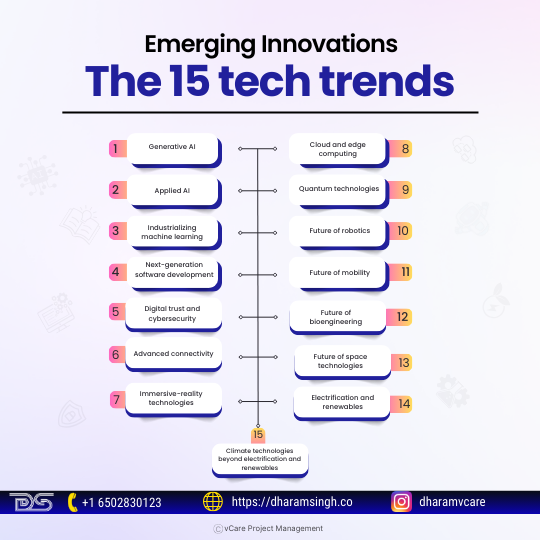
Emerging Innovations: The 15 tech trends
- Generative AI
Unstructured data, such as natural language and pictures, are used by generative AI systems like ChatGPT to create new audio, code, images, text, simulations, and movies.
- Applied AI
AI technologies utilize machine learning models to solve classification, prediction, and control problems, automate activities, enhance capabilities, and improve decision-making.
- Industrializing machine learning
The industrializing machine learning trend entails a fast-growing ecosystem of software and hardware solutions that accelerates and lowers the development, implementation, and maintenance of machine learning systems.
- Next-generation software development
Next-generation software development utilizes advanced tools and technologies for efficient code deployment, automated code generation, testing, refactoring, and translation, thereby enhancing application quality and development processes.
- Digital trust and cybersecurity
Digital trust and cybersecurity include trust architectures, digital identity, cybersecurity, and Web3, which allow enterprises to develop, grow, and retain stakeholder trust.
- Advanced connectivity
Low-Earth-orbit satellites, 5G and 6G cellular, Wi-Fi 6 and 7, and wireless low-power networks are all examples of advanced connection.
- Immersive-reality technologies
Immersive-reality technologies enable real-time interactions in three-dimensional virtual worlds, ranging from fully computer-generated VR to mixed reality and AR. They use spatial computing to interpret physical space and simulate data, objects, and people addition.
- Cloud and edge computing
Cloud and edge computing involves distributing workloads across locations like hyperscale data centers, regional centers, and local nodes to optimize latency, data transfer costs, data sovereignty, and security.
- Quantum technologies
Quantum-based technologies utilize quantum mechanics’ unique properties to perform complex calculations faster, secure communication networks, and produce higher-sensitivity sensors than classical counterparts.
- Future of robotics
The future of robotics will see advancements in robots from fixed-purpose tasks to adapting to real-life inputs with increasing autonomy and dexterity.
- Future of mobility
The efficiency and sustainability of land and air transportation are intended to be improved by mobility technologies, such as electric and driverless cars, urban air mobility, and ACES technology.
- Future of bioengineering
Bioengineering is the application of engineering concepts to biology, using technology breakthroughs to enhance health and human performance, restructure food value chains, and develop innovative offers.
- Future of space technologies
Space technologies include satellites, launchers, and habitation systems that enable new space activities and services.
- Electrification and renewables
The electrification and renewables trend encompasses the entire energy production, storage, and distribution value chain, utilizing renewable sources like solar and wind power, clean energy sources, and energy storage solutions.
- Climate technologies beyond electrification and renewables
Climate technologies aim to reduce resource consumption by removing CO2 from the atmosphere or producing materials and inputs with lower carbon equivalents.
TMO as an Enabler of Innovation and Adaptation in a Constantly Changing Environment
TMOs are becoming key drivers of innovation in a world marked by constant disruption. They help projects remain responsive and adaptable, such as during the pandemic when they focused on remote work transitions and digital-first strategies. By fostering a culture of continuous improvement and agile methodologies, TMOs enable organizations to innovate at scale, test new ideas, assess emerging technologies, and adapt to the business environment without losing sight of long-term objectives. In the future, TMOs will become centres for experimenting and scaling innovations.
The Changing Role of TMOs in a Post-Pandemic World
Organizations’ approaches to change have been permanently impacted by the COVID-19 pandemic A new function has been introduced to the TMO in the post-pandemic environment with reference to crisis management, recovery, and restructuring organizational structures. TMOs are increasingly in charge of managing hybrid work arrangements, supervising the change to more digital-first models, and negotiating emerging issues like cybersecurity, employee well-being, and changing consumer expectations.
Additionally, post-pandemic methods call for greater function and geographic cooperation, which makes a strong TMO even more essential. Leading resilience in an era of future disruption is now the office’s responsibility in order to keep the company flexible and responsive. As businesses consider their post-pandemic needs, TMOs must emphasize adaptability, foster innovation, and take on the role of sustainability champions.
Conclusion
Investing in the Future of Transformation Management Offices (TMOs)
Organizations that implement a Transformation Management Office (TMO) now will not only survive but thrive in future difficulties. Maintaining a competitive advantage requires employees who are committed to driving change and ensuring that transformation efforts are executed seamlessly. TMOs are critical in today’s fast-paced, digital-first business environment because they oversee and align transformation activities, balance rapid wins with long-term development, manage evolving technologies and promote continuous improvement. They facilitate innovation, help firms navigate digital transformation, maximize resources, and successfully manage change. TMOs can help firms be resilient and adaptable in the face of upheaval by catalysing adaptation and innovation.
Call to Action for Leaders
Leaders must invest in a Technology Management Organization (TMO) to navigate the complexity of the modern corporate world, which includes hybrid workforces, AI-driven decision-making, and a quickly changing competitive landscape. Proactively deploying TMOs can help firms navigate these changes, unleash new growth prospects, and assure long-term success.
TMOs will play a growing significance as firms adapt to a world that is changing all the time. In the years to come, TMOs will be the driving forces behind organizational change, from innovation and adaptation to AI-driven decision-making and hybrid workforce management. TMO will emerge as a strategic partner that helps companies not just survive but flourish in this disruptive environment as they confront an increasingly uncertain future.

by Dharam CW2 | Dec 11, 2024 | Professional Development Webinars
Global Strategic Portfolio Leadership | Michael Fritzsche | vCare PgMP & PfMP Success Story
Join me for an exclusive webinar featuring Michael Fritzsche, a distinguished Project Management Professional from Rheinböllen, Rhineland-Palatinate, Germany. Michael, currently the Director of Project Management at HAHN Automation Group, brings over two decades of exceptional leadership and innovation in the automation industry. His career exemplifies excellence in managing global portfolios, driving digital transformation, and fostering organizational resilience.
In this webinar Michael will share his vast expertise and thought leadership on these critical topics:
+ Implementing Effective Governance Models for Global Portfolio Success
+ Managing Risks in Global Portfolios
+ The Role of Technology in Shaping Portfolio Management
+ Best Practices for Handling Portfolio-Level Escalations Globally
+ Adapting Portfolio Strategies for Resilient Growth
+ Future Trends in Portfolio Management
Attendees will gain exclusive career and industry insights, and receive a special discount code for vCare Project Management’s upcoming certification programs.
🔗 Reserve your spot now: https://bit.ly/4fTPF3n
Session Date: Thursday, 19th December 2024
Session Time: 09:00 AM – 10:00 AM (PST) / 10:00 AM – 11:00 AM (MST) / 11:00 AM – 12:00 PM (CST) / 12:00 PM – 01:00 PM (EST) / 02:00 PM – 03:00 PM (BRT) / 05:00 PM – 06:00 PM (GMT) / 06:00 PM – 07:00 PM (CET) / 08:00 PM – 09:00 PM (AST) / 09:00 PM – 10:00 PM (GST) / 10:30 PM – 11:30 PM (IST)
🚀 Elevate Your Project Management Career:
– Book an obligation-free consultation session on Project Management Career, training, and certifications: http://talktodharam.com
– Discover training offers and certification discounts: https://bit.ly/3jWVepD
– Stay updated with our Q&A series and certification success stories by subscribing to the vCare Project Management YouTube channel at https://bit.ly/2YF0wJl
– Follow my podcasts and interviews with Project Management Experts on YouTube at https://bit.ly/2NDY8wd

by Dharam CW2 | Dec 6, 2024 | Program Management
Strategy Execution Challenges in Today’s Business Environment | Tom Witterholt | PMI PgMP | Episode 1
What are the strategy execution challenges of today’s business environment?
– Strategy execution challenges in today’s business environment
– Identify Growth Area in your Business
– Foster Employees Career Growth – Next Level Skills
– Understanding Organization Strategy
🚀 Elevate Your Project Management Career:
– Register for my upcoming PMI Certification Success Story Webinar: https://bit.ly/4fTPF3n
– Book an obligation-free consultation session on Project management Career, training, and certifications: http://talktodharam.com
– Discover training offers and certification discounts: https://bit.ly/3jWVepD
– Stay updated with our Q&A series and certification success stories by subscribing to the vCare Project Management YouTube channel at https://bit.ly/2YF0wJl
– Follow my podcasts and interviews with Project Management Experts on YouTube at https://bit.ly/2NDY8wd

by Dharam CW2 | Jul 11, 2024 | General
Many PMOs recognize digitalization as an essential step in their organizations’ journey toward project management maturity. As a result, the Project Management Office (PMO) must shift its focus from project governance and delivery to supporting digital transformation.
To keep up with the evolving demands and needs of an increasingly digitized world, digital transformation has to be drifted through organizations of all shapes and sizes. However, many realize that successful digital transformation entails changing foundational cultures, structures, and methodologies and implementing digital tools. As organizations expand to accommodate this change, the PMO’s role within those organizations must change to do the same.
Digitalizing PMOs
Digital transformation is a familiar idea. Businesses constantly look for new ways to adapt and leverage emerging technologies to improve their business processes. Before the pandemic, PTC research found that 70% of organizations had or were working on a digital transformation strategy.
The PMO is crucial to achieving an organization’s strategic goals. If PMOs are to be an organization’s strategic drivers, they must expand their role beyond its traditional boundaries. They must assume their strategic role by leading change and capitalizing on opportunities in the digital space. PMOs must be at the forefront of emerging technologies, constantly evaluating opportunities and implementing new strategies. The recent pandemic and sudden shift to remote work have highlighted the challenges of developing community and culture through digital spaces. Here are some ways that PMOs can help the organization drive into digital transformation.
Five ways the PMO drives digital transformation
- PMOs can inspire and encourage change.
- PMOs act as the strategic arm
- PMOs provide support and insight.
- PMOs properly manage transformations.
- PMOs enable successful digital adoption.
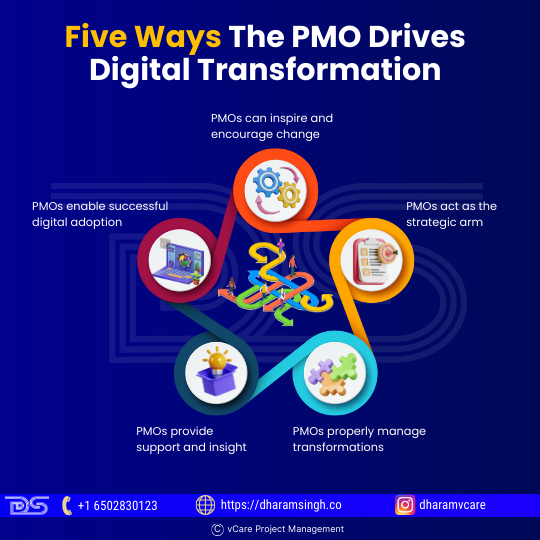
Five ways the PMO drives digital transformation
How PMOs can aid an organization’s digital transformation
The nature, ownership, and stakeholders of IT strategy, governance, and management activities are changing dramatically due to digitization. According to Gartner research, 87% of organizations prioritize digitization. Furthermore, technology is now responsible for 77% of an executive’s top priorities.
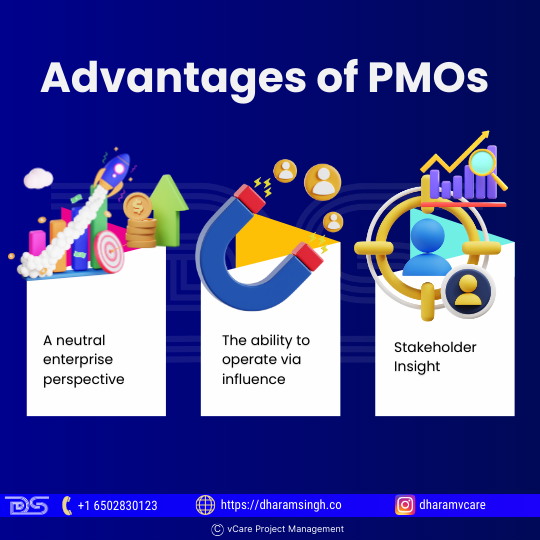
Advantages of PMOs
As a result, PMOs are under intense pressure to transform. Unfortunately, their project, program, and portfolio management processes are designed for predictability and consistency rather than the speed and flexibility required to meet digital demand. Most PMOs have three significant advantages, which are either inherent due to the PMO’s role or location or have been developed through previous experience:
- A neutral enterprise perspective: As capital allocation and portfolio prioritization approaches change to enable the funding flexibility required for digital work, the PMO’s impartial, enterprise-wide perspective on demand, investment, and resource utilization is hugely valuable.
- The ability to operate via influence: As organizational boundaries become more fluid and who “owns” project management becomes less certain, influencing and enabling others, rather than direct ownership, becomes even more critical.
- Stakeholder insight: As digitization spreads throughout the business and accounts for an increasing proportion of work, there are more first-time stakeholders and greater stakeholder complexity for each piece of work. Understanding the preferences of these various stakeholders and experiencing synthesizing their feedback becomes critical in delivering results from digital work.
Elements Driving Digitalization
Traditional businesses worldwide have long recognized that digital transformation is the key to thriving in a fast-paced world. Digital transformation involves integrating digital technology into all aspects of a business. It fundamentally alters how businesses operate and provide value to customers. It increases efficiency, transparency, customer experience, employee engagement, and culture and saves time and money. Modern digital tools have elevated the project management process to new heights.
The following are the seven critical elements of a successful strategic digital transformation framework:
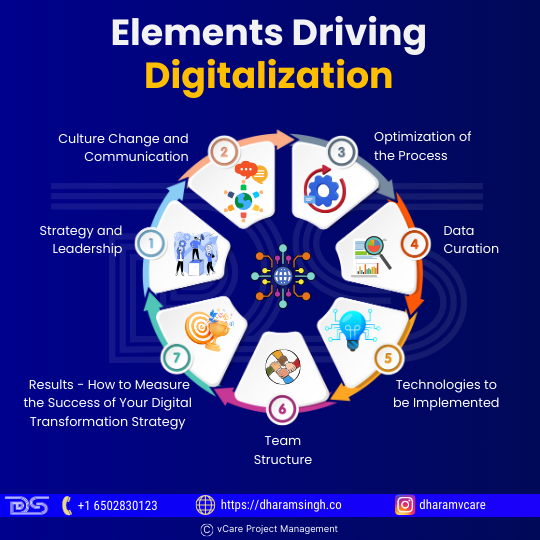
Elements Driving Digitalization
- Strategy and Leadership
An effective game plan is an obvious but frequently overlooked component of a digital transformation strategy. Instead, what matters is “how and who” formulates the strategy. A basic strategy and the appropriate technologies can help you digitize or digitalize your business, but transformation requires the right mindset and guidance. As a result, strategy combined with the right leadership is the first and most important component of an effective digital transformation strategy.
Visionary leadership combined with the appropriate digital transformation strategy can achieve a better, smoother, more cost-effective, and time-effective plan for your business’s transformation.
- Culture Change and Communication
Prepare for a massive cultural shift. A company’s clients and employees are typically resistant to significant changes, making implementing any transformation challenging. However, any successful digital transformation program must include culture. Therefore, giving your employees advanced training in good communication will be advantageous.
- Discuss the digital transformation strategy with your employees and how it will benefit all stakeholders.
- Conduct training sessions with your employees ahead of time to prepare them.
- You can prepare your employees by demonstrating the importance of aligning culture with new initiatives.
- Optimization of the Process
Every business has various processes and operations that can be improved to make workflows more efficient and effective. As a result, when developing a digital transformation strategy, consider business process optimization.
The strategy must optimize the business process while meeting customer and internal team goals. The digital transformation strategy must cover all interconnected business processes to achieve maximum output.
- Data Curation
One of the primary reasons for implementing digital transformation is to eliminate your business’s pain points for your team and your customers. But how will you know what these aches and pains are?
Data analysis and integration can assist you in locating them. People frequently choose their preferred technologies when developing transformation strategies before analyzing their data. Data analysis and the dissemination of its results can assist the team in identifying the best solutions to problems, leading to developing a better digital transformation strategy and making the most of the transformation process.
- Technologies to be Implemented
Finding the right technologies for your business is one of the most crucial steps in creating a digital transformation strategy. Introducing new technologies into your business will necessitate a significant financial investment, so it must be done correctly to avoid the need for additional funds. Any impactful strategy for digital transformation will always include options and budget constraints to help you make the best decision possible. Whether dealing with legacy system updates, application modernization, or implementing entirely new digital systems, you must find the best technology.
Some cutting-edge technologies that must be incorporated into your digital transformation strategy are:
- Cloud and Distributed Platforms
- Data Analytics & Artificial Intelligence
- Digital Experience and Digital Reality
- Team Structure
Harvard Business Review says digital transformation is about people, not tools. As a result, team structure is a determining factor in delivering results by the Digital Transformation Strategy.
The scope of the project should determine the team structure. The following components should be included in the digital transformation initiative:
- Pack of Leaders
- Business Experts
- The cast of Coders and Designers
- Results – How to Measure the Success of Your Digital Transformation Strategy
Your company’s digital transformation outcomes will greatly influence how you lay out your strategy. The outcomes will always vary depending on the practices and technologies used. Your digital transformation strategy’s success is dependent on its agility. First, of course, you must stick to your detailed strategy, but you must also be open to changes if things don’t go as planned.
By developing an effective, clear, and robust digital transformation strategy, you can ensure your company’s digital transformation goes as smoothly as possible. A digital transformation strategy is similar to a personalized road map for significant changes in your business operations. However, it requires significant financial investment, time, and technical expertise.
From Traditional PMO to Agile
Traditionally, PMOs have focused on maintaining project control to complete projects on time and within budget. However, in today’s increasingly complex and changing competitive environments, agile management is gradually displacing more traditional management methods; PMOs that remain anchored in this “classic” management model risk disappearing if they do not set the following objectives:
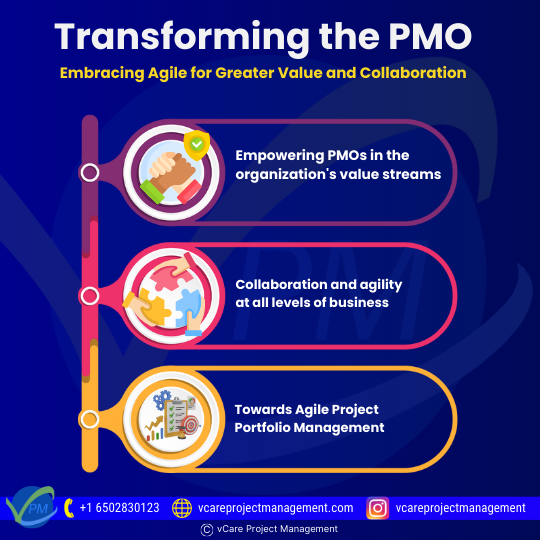
Transforming the PMO
- Empowering PMOs in the organization’s value streams
Organizations are now focusing on the value they provide to their customers and how different areas and departments contribute to that value creation. Suppose PMOs stick to their command and control model to ensure that projects are delivered on time and within budget. Their contribution to the organization’s value streams will be marginal, and senior management will view them as an unnecessary expense for the company.
- Collaboration and agility at all levels of business
Silo-based organizational models need to gain ground in agile and collaborative environments. As a result, PMOs must evolve beyond simply providing Project Managers with the tools they need to complete the organization’s projects.
On the one hand, PMOs must maintain open lines of communication with senior management to align the Project Portfolio with the organization’s goals. On the other hand, it serves as a reference point for stakeholders and project work teams, providing real-time information on project status and support at all levels for proper project implementation.
- Towards Agile Project Portfolio Management
Change is the norm in this new competitive environment, with highly volatile markets demanding businesses to bring products and services to market as quickly as possible. As a result, company objectives can shift dramatically quickly, necessitating a rethinking of project portfolio prioritization. This phase is where PMOs must adapt to this new environment and manage key project management issues like prioritization, resource management, budgets, or delivery dates in an agile manner, as well as learn to react to changes in their project portfolios in an agile and efficient way without losing sight of the organization’s objectives.
Post-pandemic challenges for PMO
If PMOs establish these three goals, they might avoid extinction because senior management will no longer recognize their value to the organization.
It will be challenging, and the Project Management Office will face several challenges as it adjusts to the new reality. In particular, the PMO will face some challenges for its role to be perceived as critical to the organization’s value streams:
- Coincide the project portfolio with the overall strategy of the organization.
- Resource management is a real challenge for PMOs.
- Responsiveness to changes in the project portfolio.
- Fluent in communication with the organization’s senior management.
- Embrace Agile Leadership.
- Standardization of processes and workflows.
- Renewal of project portfolio management tools.
Mitigating mediocre implementation of Programs
There are always equal chances of success and failure in programs/projects. As a result, it is critical to understand how to avoid and overcome project failure. There are numerous reasons why a PMO succeeds or fails. Still, the most common reasons for failure are often not related to process or technology issues but to “people issues” in an organization.
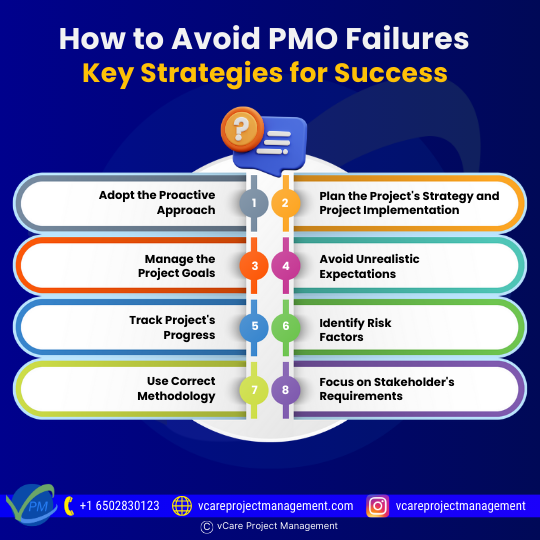
How to avoid PMO Failures
Here are the most common reasons why PMOs fail:
- Adopt the Proactive Approach
After many years, project managers gain the skills and knowledge needed for the current project from their experience. As a result, an experienced and highly skilled project manager is equipped to deal with customers and avoid project failure. If you are new to project management, consult a professional mentor to discuss your concerns and receive appropriate advice based on their experience. If you have project management experience, you should apply your skills and knowledge to the project and be aware of the common causes of project failure.
- Plan the Project’s Strategy and Project Implementation
The most important stage of any project is planning. Most of the time, proper attention is not given during the planning stage. If you plan properly, you will increase the project’s chances of success. After scheduling your project, use the Project Management Life Cycle to begin project execution.
- Manage the Project Goals
It would be best to document the project’s decisions, actions, and outcomes before beginning, during, and after completion. To avoid project failure, it is always necessary to ensure project deliverables and work appropriately with customer requirements. Never rely on understanding, verbal agreements, or memory for project implementation decisions.
- Avoid Unrealistic Expectations
Always set realistic expectations and time frames with stakeholders, team members, or customers to meet your project’s deadline. This move is related to the proper project start but goes deeper until completion. To avoid project failure, realistic expectations for team members must be set based on their capabilities. It would help if you encouraged them to work enthusiastically and push themselves beyond their comfort zone to meet the project’s objectives.
- Track Project’s Progress
Project planning will assist you in determining where your project should be now. In addition, you should know how much of the work has been completed, whether your work is on schedule, proceeding as planned, and so on. These three parameters govern any project and are critical in preventing project failure.
- Identify Risk Factors
The best way to avoid risk is to identify, analyze, and respond to risk factors. So, if you identify the risks and potential issues early on in the project, your project team can avoid them with appropriate actions. In addition, identifying and resolving risk factors will assist the project manager in lowering the likelihood of project failure. As a result, you can perform proper risk management and avoid project failure.
- Use Correct Methodology
One of the most important decisions a project manager must make is the methodology to use for project management. What you choose will have a significant impact on teamwork. However, each methodology has advantages and disadvantages depending on the project type and scope. Here are some top project management methodologies to consider.
- Waterfall method
- Agile/Scrum
- Hybrid approach
- Critical Chain Project Management
- Integrated Project Management Technique
- Critical Path Method (CPM)
All project management methodologies cannot be regarded as the best for all projects, so one can understand the project requirements and select the best option. The correct methodology will assist you in achieving the project goal within the specified time frame, thereby avoiding project failure.
- Focus on Stakeholder’s Requirements
As we all know, a project will only succeed if it meets its objectives and exceeds the expectations of its stakeholders. Therefore, to be successful in project management, all team members must be actively involved in the project and committed to its success. Devoting entails writing down the following stages:
- The competent initiative assists the team in implementing various tasks throughout the project life cycle.
- Adequate funding ensures the organization’s cost-generating department has enough money to fund the projects.
Final Thoughts
In today’s fast-paced and dynamic business environment, agile working methods might provide significant added value that should be noticed.
Digitalization is making projects more complex. As a result, the use of technology to manage projects is growing, and project teams must be cross-functional to achieve project goals. Agile project management provides an opportunity to respond quickly to new requirements and be more visible in the market. For organizations that use a traditional approach to project management, the transition to an agile PMO is part of their digital and agile transformation.
It should be noted that this is not an evaluation of “better” or “worse” methods. When used correctly, each project management method can reveal its strengths. It is critical to think about, use, and improve them.











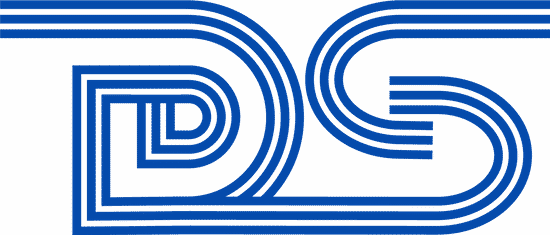




















Recent Comments